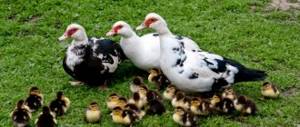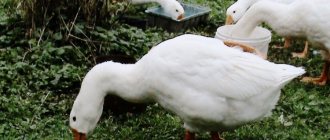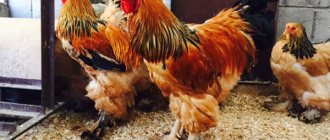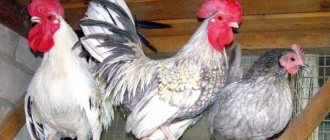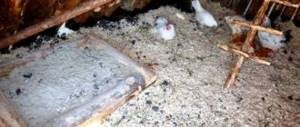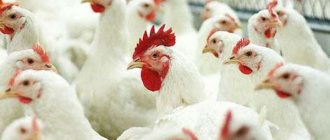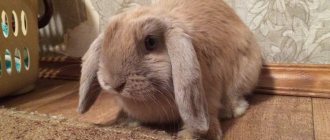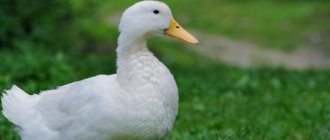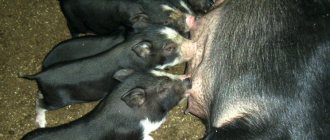The unique Lakenfelder chicken is on the verge of extinction. Until the 21st century, the breed was popular. This farm bird owes this attention to its good performance by previous standards and impressive appearance. Subsequent successes of breeders in the field of breeding highly productive chicken varieties shifted the former favorites from the pedestal to the backyard of the poultry yard. Let's look at the advantages and disadvantages of the Lakenfelder breed.
Origin of the breed
Little is known about the appearance of these chickens. It is believed that the breed was bred by farmers living in the territory between Germany and Holland, in particular in the regions of Rotenberg and Lagerfelt. The breed with the egg direction was named in honor of the latter.
There is also a myth about the origin of Lakenfelder chickens. It stated that 2 thousand years before the birth of Christ, a certain group of Indian sages, calling themselves Ah-Brahmans (translated as “holy people from the Brahmaputra”), emigrated to Mesopotamia.
Having settled in Palestinian Armageddon, they began breeding chickens, trying to improve the quality characteristics of the breed. First of all, the beautiful singing of roosters and large eggs of chickens were valued.
In Western written sources, Lakenfelder chickens were first mentioned in 1727. At the beginning of the 20th century, they appeared in Great Britain, and the American continent saw birds in 1939.
The largest populations were found in Holland and Belgium. But now this breed is no longer in demand, because there are chickens that produce more eggs and meat. European scientists are fighting to save Lakenfelder from degeneration.
Origin story
Presumably, the ancestors of individuals of this species were aboriginal chickens from the Dutch town of Lakervelte and the Belgian town of Zotterge. The specific names of the breeds that were used for crossing have not been preserved (such information has been lost over the years). But one thing is known - these breeding works were carried out so that Dutch farmers could get tasty meat and eggs from new chickens.
Mother hen of this breed
For many decades, these chickens were actively bred both in the Netherlands and Belgium. But over time, new, more productive varieties of these birds began to appear, and Lakenfelders began to be undeservedly forgotten. Therefore, the genetic material of this breed is stored in these countries, and the number of individuals is artificially maintained thanks to the efforts of special organizations. These chickens are a versatile meat and egg breed.
External signs
Exterior
Representatives of the Lakenfelder breed look royal. The expert description is as follows:
- a medium-sized body of a streamlined shape, straight, dense, slightly elongated;
- the neck of medium length is stretched upward, smoothly flows into the body, covered with blue-black feathers;
- the head is small in size, the skin on it is bright red;
- large leaf-shaped comb with 5-6 expressive teeth;
- medium-sized red earrings are oval in shape;
- lobes of the same shape are painted white;
- large eyes - orange or red;
- beak – small and gray;
- shoulders wide apart;
- the full chest, like the stomach, clearly protrudes forward;
- the body is covered with white feathers;
- shins are medium in size, regular in shape, metatarsus is small;
- fingers widely spaced;
- powerful limbs of ash-gray color;
- long wings are pressed tightly to the body, the feathers on them are black or white;
- the lush blue-black tail is located at an angle of 60 degrees to the body;
- The braids are long and gracefully curved, completely hiding the tail feathers.
Gender differences and colors
Lakenfelder hens differ from roosters in their body build. Their back is straight, parallel to the ground. The stomach protrudes forward. The comb of laying hens is modest in size, as are the earlobes.
Farmers believe that the larger the rooster's earrings and comb, the better he performs as a producer.
The classic color of the breed: the neck, tail and wings are painted deep black, and the body is white. There are other color options.
Silver - found on the American continent. These birds have much more white feathers. They cover the body, wings and part of the tail.
Platinum - the beige feathers of these birds are completely replaced by black ones, and the limbs are light gray in color.
Description of Lakenfelder chickens with photos and characteristics
Lakenfelder chickens have a memorable appearance. Once you see a rooster of this variety, it is difficult to confuse it with representatives of other breeds. According to the standard approved in America, there is only one option for plumage color - white feathers on the body and wings, and black feathers on the tail and neck. In other countries, other types of color are also recognized - golden, platinum and silver.
Birds exterior
The Lakenfelder rooster is not large, its weight does not exceed 2.3 kg. The chickens are even smaller – up to 1.8 kg. The birds are well built and have a graceful appearance.
Characteristic features of the exterior:
- compact, knocked down cylindrical body;
- wings tightly fitting to the body;
- the back is straight;
- neck of medium length;
- the chest protrudes slightly forward;
- small head with an erect leaf-shaped red crest;
- face is red;
- earlobes are large and white;
- oval earrings, red;
- gray beak;
- eyes large, red-orange;
- limbs of medium length with bare metatarsals of a smoky color;
- the tail is fluffy with long curved braids;
- plumage density is high.
Laying hens differ from roosters in having smaller body dimensions and more rounded shapes. The comb and earrings of chickens are less developed. Females have more white in their plumage; black is present only on the short tail and mane. A few dark blotches are acceptable on the body.
Temperament of birds
Lakenfelder chickens have an interesting character. Breeders generally speak of them as peace-loving birds, but note that if a threat arises, the roosters can still fight with the enemy. Laying hens are noisy, they cluck loudly if they do not see the head of the chicken coop nearby or are deprived of the opportunity to walk.
It is not uncommon for chickens to lay eggs not in nests, but somewhere in a secluded corner of the garden, under a bush. Lakenfelders love to spend long periods of time outdoors, even in rainy weather. In summer they return home at dusk.
Productive qualities
The productivity of Lakenfelders is at an average level. Modern hybrid varieties of birds are much ahead of them in the yield of meat and eggs. Perhaps for this reason the breed was forgotten.
A hen in the first year of laying brings 165–190 eggs with an average weight of 55 g. The durable shell has a brown tint. The maturation of laying hens is completed by the age of six months. The young are characterized by good viability - no more than 5% of hatched chicks die.
Attention! When breeding Lakenfelder chickens, you need to take into account that of the entire brood, only 30–50% of chickens meet the approved standard.
The meat productivity of this breed line is also mediocre. Birds reach maximum body weight at the age of 9 months. An adult rooster weighs 2.5 kg. The meat of young individuals has a delicate structure and a pleasant taste and aroma. With age it becomes stiffer.
Character of birds
The Lakenfelder chicken breed has a calm character. Birds are wonderful neighbors who do not start quarrels or showdowns. Roosters fight very rarely, so they are kept together with hens.
Lakenfelder chickens quickly get used to new spaces. They tolerate small areas of coops well, although they are active. Need regular walks outdoors. They love to spend time in the garden.
Roosters only show aggression when in danger. Chickens can make noise if they are not allowed to roam the coop. Birds are not afraid of inclement weather; they do not hide from the rain. But with the onset of darkness they always return to their roosts. There are descriptions of cases when laying hens began to worry due to the absence of a rooster.
Breeding problems
Fans of exotic purebred chickens have made an unpleasant discovery: the West is reluctant to sell high-quality purebred animals to Eastern Europe. Motivation: you cannot save the breed. This is partly true, since due to the small number of rare exotic chickens, breeders are forced to mix breeds.
Problems with breeding Lakenfelders in Russia may be associated precisely with the sale of culls instead of elite birds. Because of this approach, Russians are at odds about when Lakenfelder chicks develop color: either in a month, or after the juvenile molt. Although professional Western breeders are also not free from certain problems: the color of Lakenfelders is established late. The photo shows day-old chicks of the Lakenfelder breed.
The chickens are “Western”, but at this point it is impossible to say exactly what color they will be. Culling of Lakenfelders intended for show is carried out after the juvenile molt.
Western breeders have already accumulated some experience that allows them to early determine what the color of future chickens will be. It may not be 100% guaranteed, but it does allow unwanted chicks to be culled at an early stage. The video shows how to determine the future color of chickens. The author of the video focuses on certain signs. Since additional pictures are given, the video is understandable even for those who do not know English.
problems with color and, possibly, with the purity of the breed are clearly visible in the photo of young Lakenfelder chickens.
But the quonka has a crest hanging from it. Perhaps this is not a purebred chicken, causing the chickens to be split in color.
In Russia, only a few farms breed this breed, so it is difficult to get eggs from purebred Lakenfelders.
Productivity characteristics
Lakenfelder chickens are kept not for their valuable qualities, but for aesthetic reasons. The spectacular contrasting appearance of the birds pleasantly decorates the poultry yard.
Let's look at the characteristics of the Lakenfelder chicken breed.
Weight: rooster - 2.2-2.7 kg, chicken - about 1.5-2 kg.
Average life expectancy is 7 years. Chickens are most productive in the first 2-3 years; after 5 years they stop laying eggs.
Maturity occurs at 6 months, but maximum weight is reached at 9 months.
The egg production of one hen varies between 160-190 eggs per year.
The eggs are light cream in color and the shell is dense. The weight of one is 50-55 grams.
Survival rate of young animals is 95%.
Compliance of chicks with the standard is within 50%.
The breed's egg production can be increased by introducing finely chopped eggs and shells into the diet.
During molting, chickens do not lay eggs at all or partially. This natural process continues for 2 months, usually in winter.
Lakenfelder chicken breed
A description of the Lakenfelder chicken breed is of interest to breeders who are interested in the history of rare and ancient varieties. In the 18th century, this breed, related to the meat and egg breed, was popular and in demand in European countries. There are now approximately 1,000 purebred Lakenfelder chickens worldwide. Thanks to the efforts of enthusiastic scientists, the population still exists.
Conditions for keeping birds
Basic
Lakenfelder chickens will need a spacious coop. These birds are not kept in cages. It is advisable to make the perches high.
A walking enclosure with a closed top is a must. Chickens of the Lakenfelder breed can fly well (up to 3 meters), so they can escape from it. In addition, such fencing will help protect them from aggressive chicken breeds.
Individuals have dense plumage, so they walk outside at temperatures down to minus 10 degrees. On average, they spend at least 10 hours outdoors.
The poultry house should still be insulated and heated, especially if there are chicks in it. In addition, the birds themselves do not lay eggs in cool conditions. The desired thermometer level is 5-10 degrees Celsius.
Additional
The remaining requirements for their habitat for Lakenfelder chickens are standard.
The bedding on the floor and perches is made of straw, sawdust and peat. It should always be clean and dry.
A container is placed in the chicken coop, into which one part of sand and two parts of ash are poured. They are needed for “bathing” chickens, which are thus freed from parasites on the body. Change the mixture once a week.
It is necessary to provide chickens of this breed with enough light. Illumination indicators - at least 30 Lux. The Lakenfelder's day lasts about 15 hours.
Humidity is maintained at 60-70%.
Maintenance and care
Representatives of the Lakenfelder breed are only suitable for floor-type housing. Despite their small body size, they feel uncomfortable in cages. Birds love to spend time actively, so they need a walk.
Requirements for arranging a chicken coop
Lakenfelders have thick and dense plumage and are not afraid of the cold. They are kept in an insulated poultry house on thick bedding without heating, if the temperature inside does not drop below +13 degrees. Dampness and drafts are the main enemies of birds. To maintain a normal level of humidity in a room, you need at least a primitive ventilation system.
Birds are not picky about their living conditions. The chicken coop is equipped according to standard recommendations. Perches are installed inside at a height of 100–120 cm. Each individual should have at least 30 cm of pole length. The nests are placed in a dark area, protected from drafts. For 4–5 laying hens you will need 1 box.
Drinkers and feeders are placed on the floor in an accessible place. Each bird is allocated 12 cm of feed tape. It is worth installing electricity in the barn in advance, because in winter you will have to light the chicken coop. This is necessary to increase the productivity of laying hens.
Maintaining cleanliness in the poultry house is the main task of the breeder. Litter that accumulates on the surface of the litter must be removed weekly. Twice a year the premises are thoroughly cleaned and disinfected.
Walk
Lakenfelder chickens spend most of their time outside in the summer. They can be released during the cold season, but walks should not be long. A spacious area is built for the birds, equipped with a canopy that will protect them from rain. Birds fly high, so it is worth sewing up the walking yard with netting.
Representatives of this breed are good foragers. They love to dig in the ground, looking for food. It is worth sowing the walking area with grass so that the birds will peck at it. Greens make up 20% of the chickens' diet and are a valuable source of vitamins. It is recommended to place a large basin with a mixture of ash and sand in the yard or chicken coop. Floundering in it, the birds clean their feathers of parasites.
Features of feeding
Their health and productivity depend on the quality of the birds’ diet. Whenever possible, poultry farmers prefer ready-made feed. If the menu for birds is compiled independently, then it includes:
- different types of grain - millet, corn grits, millet, barley;
- legumes – peas, lentils;
- greens and vegetables;
- sunflower meal;
- boiled fish;
- mineral supplements - chalk, crushed shells, eggshells, bone meal.
In summer, feeding is done twice a day - at dawn and before the birds go to bed. During the day they have the opportunity to feed on pasture. In winter, when part of the energy is spent on heating, there is a need for additional food intake. For lunch, the birds are offered mash cooked in broth or whey. They add herbal flour, yeast, fish oil, a little chalk and salt. Grain sprouts are a valuable source of vitamins in winter.
Attention! It is important to train your chickens to eat at the same time every day. You should not take long breaks between feedings. Hungry birds densely fill the crop with grain, and this leads to its clogging and causes an inflammatory process.
Possible diseases and their prevention
The Lakenfelder chicken breed is characterized by stable immunity. Birds rarely get colds. Health problems are often caused by poor living conditions and poor nutrition. A poor diet, not enriched with vitamin and mineral supplements, is the main reason for the development of vitamin deficiencies and metabolic disorders.
In unsanitary conditions, birds suffer from infection with skin parasites. It is important to keep the poultry house clean and disinfect it regularly. Timely vaccination of livestock will protect against infectious diseases.
Diet and diet
General standards
By about 25 weeks, individuals reach maturity. For Lakenfelder chickens, it is not recommended to make food yourself - it is difficult for beginners to take into account all the nuances when preparing it. It is better to buy ready-made certified mixtures. Carefully study the description of the composition and recommendations of the manufacturers.
At one time, the bird needs 150-200 grams of feed. Remains of food are removed 20-30 minutes after the start of feeding. This way you can train your chickens to eat the whole mixture at once.
In the winter season, chickens and roosters are fed 3 times a day: morning, afternoon and evening, and in the summer - only 2. In the warm season, Lakenfelder chickens eat plants while walking, so they provide themselves with lunch.
Favorite treats are all kinds of wet mash. Premixes should not be added to the diet. They will not produce any results, but they can harm the chickens. From time to time, birds should add yeast, shell rock and fish oil to their feed. Pay close attention to the presence of clean water in drinking bowls.
Menu for laying hens
Variety is added to the diet of laying hens with the help of ground cereals: corn, millet, oats and wheat, as well as bran. To improve egg production, boiled eggs with shells are added to the feed. In winter, they and other birds must be fed with grass meal or hay.
During molting, Lakenfelder chickens are fed vegetables into the feeder: carrots, potatoes, pumpkin, as well as beet and cabbage leaves.
Feeding the chickens
In the first days after birth, the young animals are fed boiled eggs with herbs or cottage cheese. After 2 weeks, you can add yogurt or porridge to your diet.
By the age of one month, they, like their parents, are fed with mixed feed. One chick needs only 20 grams of food at a time. Foreign manufacturers produce ready-made grain mixtures that are designed specifically for chicks.
Description of the breed
The history of the origin of this species, unfortunately, has not been reliably preserved. According to some sources, the homeland of Lakenfelders is Belgium, but there is information that such birds owe their appearance to breeders from Holland. It is in this country that there is a city of the same name, Lankenwelte, which gave the name to the breed.
Pictured are chickens of the Lakenfelder breed:
If the past of these chickens is hidden from us, then the future is even more uncertain, because the number of these birds is constantly declining. Breeders do not want to raise chickens that are capricious in breeding, preferring other highly productive species. Most likely, Lakenfelder will remain as decorative specimens, because its spectacular appearance is an almost sure-fire trump card of this species. It is also worth learning more about what the description of the Ukheyiliu chicken is.
If you want to breed chickens with high egg production, you should pay attention to the description of the Redbro chicken.
It is also worth paying attention to the chicken Yurlovskaya Volosistaya, and for this you should follow the link.
It’s also worth looking at what Bantamka chickens look like in the photo: //gidfermer.com/pticy/kury/bentamka-poroda.html
You may also be interested in learning about what Welzumer chickens look like and what are the features of their breeding.
The character of these birds is also special. Chickens are not phlegmatic, they are always on the move. Roosters are more reserved, but well-developed wings and leg muscles allow them to fly high. That is why, when kept in an aviary, breeders recommend stretching a net over the top. This will protect young animals from attacks by aerial predators, and will deter adults from “searching for adventure.”
Bettas can be somewhat aggressive, but usually get along well with other poultry species.
With chickens such problems do not exist at all. They willingly hatch eggs of other breeds that do not have such a strong maternal instinct. Lush plumage helps keep warm, and a calm disposition will allow you to easily care for the hen without the risk of attack. You may also be interested in information about breeding Xin Xin Dian chickens.
The video shows a description of the Lakenfelder chicken breed:
Basic characteristics of the breed
Of course, Lakenfelders, unlike Liven Calico chickens, cannot compete with modern highly productive breeds. Their indicators are more than modest, although this species belongs to the meat-egg category. The weight of an adult betta rarely reaches 2 - 2.5 kilograms. Hens, despite their more modest dimensions, grow about a kilogram heavier than males.
The meat has a delicate structure and in some respects exceeds standard breeds. In some countries it is considered almost a delicacy, which gives hope for the revival of the popularity of Lakenfelders.
Other productivity options:
- Egg production reaches 180 – 220 eggs per year.
- The average weight of eggs ranges from 56 to 62 grams.
- The color of the eggs is light beige.
Despite their modest size, Lakenfelder birds look very impressive. This is achieved to a greater extent due to the voluminous and spectacular plumage. The neck, tail and partially wings are black. The rest of the body is snow-white. The paws are very strong, well developed and dark gray in color. On the head, a jagged ridge and a town stand out as a bright spot. It is the unusual color that makes this breed memorable among many others.
At the same time, it is worth noting the main problem in professional breeding. The fact is that the offspring are more likely to not inherit the characteristic Lakenfelder color. Most young individuals are born with an indeterminate plumage color, which often shows gross breed errors. In some chickens, these errors disappear after molting; in some “exhibition specimens,” on the contrary, uncharacteristic features in the plumage appear over time.
In general, Lakenfelder is a breed for patient breeders who do not rush to conclusions and select individuals taking into account all requirements and criteria.
Breeding and care
Initially, this breed should be very productive and resistant to characteristic diseases. During the selection process, it was not particularly possible to instill these qualities, so keeping birds is not as simple as it might seem. Most often, distrust and reluctance to own Bressgal chickens, like the Lakenfelder breed, is associated with the intricacies of further care.
The video shows the correct feeding of chickens:
Features of breeding chickens:
- Unlike the Dekalb chicken breed, the birds are distinguished by a well-developed maternal instinct, so problems with hatching are not expected.
- The hen must be separated from the main herd, ensuring peace and a relatively high temperature in the room.
- After birth, hatched chicks must be dried and warmed. After a couple of hours, it is advisable to immediately feed it with age-appropriate combined feeds.
- From two to three days of age, grated eggs and cottage cheese can be introduced into the diet.
- Greens and young grass are considered an essential part of the diet of young animals.
- In the first week of life, chickens are fed exclusively with boiled water with a small addition of manganese. This promotes digestion and is a good prevention of stomach disorders.
- From the age of one month, the chickens are transferred to the main contingent and on a regular diet.
But how to breed Tsarskoye Selo chickens, and what features exist, is described in great detail in this video.
Further care comes down to providing all the necessary conditions, feeding and cleaning the premises. Chickens of the Lakenfelder breed are very sensitive to temperature changes, so in winter it is necessary to think about heating the chicken coop.
The room should be spacious enough; keeping them in cages is not entirely suitable, as the chickens will waste away and get sick. It is imperative to consider dry and clean bedding (hay, straw, peat or sawdust) for the floor.
There should always be water in the drinking bowl. The health of pets depends on its freshness and quality. In winter, it is also advisable to provide hygiene procedures using ash baths. This is an excellent prevention of parasitic infestations. Also, laying hens should always have plenty of sand, shell rock or chalk. Crushed egg shells can be used as a mineral supplement.
Breeding
Maternal instinct
Lakenfelders are wonderful mothers, unlike chickens of many other breeds. Laying hens not only hatch the eggs, but also carefully look after the chickens.
Description of the appearance of the babies: yellow fluff with a golden tint, small black spots on the back of the head. Chicks do not always have this color; sometimes they are born completely black or white. The weight of a newborn is about 40 grams.
Lakenfelder chickens do not grow quickly. By 3 months, their weight is only half that of their peers of other breeds. But there are usually no difficulties with them. About 95% of chicks become adults.
Baby care
After the babies appear, they are wiped, dried and placed in a box with clean, warm flooring. Lakenfelder chickens need temperatures above 30 degrees in the first days. Every week the temperature is lowered by 2-3 degrees.
The first feeding is carried out after 12-14 hours.
Artificial lighting should not be turned off for several days, then it is turned on in the same way as for adults.
The chicks sing only with a weak solution of potassium permanganate (2-3 grams per 1 liter of water).
At one month of age, babies are transferred to adults.
Difficulties in breeding offspring
The main difficulty in breeding young animals is that usually only 50% of them meet the characteristics of the breed. This is a very high percentage of culling. Chicks that fail the purebred test are separated and raised with other chicken breeds.
Such an analysis of chickens can be carried out no earlier than a month after their appearance. But it does not guarantee that the young will grow into purebred chickens.
Breed Features
Chickens have a very active and cheerful disposition. They are easily tamed, which does not prevent them from creating problems for their owners, since sitting cooped up is not for these birds. The Lakenfelders successfully prove to owners that locking poor chickens in a cramped space is not in the owner's interests. Birds are excellent foragers and, at the first opportunity, fly out of the aviary in search of food in the garden. To keep them, you need not only a spacious enclosure, but also a closed one at the top.
The breed is able to withstand cold weather. Even very small chickens survive temperature changes well in the brooder. They thrive in conditions in which chickens of other breeds begin to get sick.
These chickens live for 7 years. They are able to produce the maximum number of eggs during the first 3 years. During this time, it is necessary to have time to raise young animals to replace the old herd. And do not forget about refreshing the blood, otherwise productivity will not only decrease, but the size of the bird will also decrease. They pause in egg laying for 2 months. This is the molting period.
Chickens are excellent brood hens and hens. They are able to hatch and raise chickens themselves.
The disadvantage is slow growth: chicks reach half their adult weight only by 3 months. The disadvantages include the difficulty of breeding purebred birds. This is not about the survival rate of the livestock, but about compliance of the color with the standard.
Benefit from breeding
Where to buy purebred chickens
You will have to work hard to buy a purebred individual. The main suppliers of chicks are Western countries, in particular Germany and Holland. They are reluctant to sell chickens to other countries. Reason: inability to maintain the purity of the breed. To breed Lakenfelder chickens, you need the same purebred individuals. And the latter, as a rule, are not enough.
Various companies often sell discards under an elite guise. True, this opens only after the first molt or when the chick reaches one month of age. Therefore, having bought chicks from trusted sellers, you cannot be sure that the young animals are purebred.
In Russia
In Russia there are agricultural productions focused on breeding Lakenfelder chickens. For example: Kingdom of Chickens, Moscow. The cost of birds is quite high:
- hatching egg – 150-200 rubles;
- chicken 1-2 weeks – 450-600 rubles;
- chicken – 1000 – 1500 rubles;
- rooster - from 1500 rubles.
To buy enough chickens for breeding, you need to pay a considerable amount. This breed does not produce as many eggs and meat as modern crosses. Therefore, breeding the breed is absolutely unprofitable, at least in the early years.
Character Lakenfelder
Unlike many of their relatives, Lakenfelders do not cause problems for their owners because they have a very calm character. If families are formed correctly (1 leader per 10 chickens), you don’t have to worry about order in the chicken coop.
Roosters are brave, but they show this extremely rarely - only if their charges are in danger. The rest of the time they behave sedately and reservedly. A distinctive feature of such a herd is that they are incredibly loud and active - you won’t be bored with them.
Possible diseases
Are there any problems
Lakenfelder chickens do not cause problems to their owner. Trouble arises when they start to hurt. The cause of the disease usually lies in improper care.
The following diseases can be found in chickens of this breed.
Salmonellosis
Intestinal disease caused by pathogenic microorganisms. A person can become infected by eating infected poultry or drinking a raw egg.
Symptoms: the bird hardly eats or drinks, the stool foams, the eyes water, and the joints, cloaca and peritoneum become swollen.
Treatment: furazolidone or streptomycin, the dosage is indicated in the instructions. Add to chickens' drink or feed. Apply the first for 20 days, the second for 10 days.
Coccidiosis
The disease is caused by parasites. Chickens usually become infected with them while walking in warm, rainy weather, when the pathogens are especially active. The disease spreads quickly among birds living under the same roof. As a result, up to 80% die.
It is difficult to recognize the infection in the early stages. Symptoms: Chickens usually do not eat, but they drink a lot. The comb turns blue. The bird itself is lethargic and drowsy, spends all its time near the wall, and hardly moves. The droppings are foamy and liquid, and the cloaca is inflamed.
Treatment: add furatsilin or furazolidone to food and drink.
Pasteurellosis
Causes of the disease: pasteurella are pathogenic bacteria. Chickens usually get sick. If the disease is not recognized in time, the birds will die.
Symptoms: blue comb and lack of appetite.
Treatment is with sulfamethazine or norsulfamethazine. It is no longer possible to cure an infection in its later stages.
Typhoid
An infectious disease transmitted through the air.
Symptoms: inactive lethargic behavior of individuals, foamy droppings, lack of appetite. The young flock together and squeak.
Infected chicks cannot be saved. Treatment of adult chickens: biomycin or furazolidone is added to food or water.
Disease Prevention
To avoid infection of birds, a number of preventive measures are taken:
- keep the poultry house clean, regularly change flooring, remove bird droppings;
- drinking bowls are constantly filled with clean water;
- use high-quality food, and throw away old uneaten food;
- Provide chickens with containers filled with sand and ash;
- disinfect the chicken coop;
- the sick animal is immediately quarantined;
- chickens are vaccinated.
Breeding Features
Puberty in Lakenfelder chickens occurs at the age of 6 months. The chicken family must be formed at the rate of 1 male per 10 females. An individual with defects in color or conformation is not allowed for breeding. Eggs for incubation should be taken only from laying hens that have reached one year of age and have managed to show their high productive qualities.
Birds of this breed are considered good hens - they readily hatch chicks, and then carefully protect them. An important condition for successful breeding and maintenance is the need for “blood rejuvenation.” That is, once every three years the owner must purchase a male or female from another tribe.
Lakenfelder chickens have very mediocre productivity indicators, so they are bred mainly for their decorative appearance, which is clearly visible in the photos presented, and the description also notes excellent maternal qualities.
These are quite freedom-loving and nimble birds, so they need to be kept in a spacious enclosure with a closed top. Otherwise, the plantings may suffer, as fidgets will certainly fly over the fence and enter the garden. It is not recommended to trim their wings, as this will spoil the decorative appearance. Caring for Lakenfelder chickens involves providing comfortable conditions for keeping, feeding and walking.
You may be interested in:
Review of the best breeds of laying hens with photos and names Household owners who raise chickens for eggs need to purchase breeds with high egg production….Read more…
Flaws
- Average productivity indicators.
- Problems in breeding.
Now you know what makes Lakenfelder hens special. Decide for yourself whether you want to grow them or not, but remember that growing them is a contribution to the great cause of preserving laying hens.
Good luck and prosperity to you!
Don’t forget to subscribe to site updates to be the first to read new information about feathered beauties.
Share the material on social networks - your friends will be curious to know about rare chickens. Did you like our tips? Share with friends on social media. networks! See modern products for poultry and livestock farmers that improve the health of pets and make our work easier.
Hatching instinct
For modern poultry farmers, the absence of their basic instinct in hens is no longer a problem. After all, you can breed chickens using an incubator, or by placing the eggs under another responsible “mother”.
But, in this case, you won’t have to resort to such methods - the description of the breed of Lakendelder chickens says that they have everything in order with maternal instinct.
But problems in breeding still cannot be avoided. That is why this species was on the verge of extinction. The fact is that among the resulting offspring, only half meet the standard.
Chickens that do not fit the description of the standard are discarded and kept separately. The breeding procedure is quite complicated, so basically only professionals do this.
Today in Russia there are several farms that offer hatching eggs and chicks for sale, and their cost is quite high.
Breed standards
The description of the Bielefelder chicken breed in accordance with the standards of the German Pedigree Poultry Federation includes the following characteristics:
| Signs | Characteristics | |
| Rooster | Chicken | |
| Marking ring size (mm) | 22 | 20 |
| Body | Massive elongated body | Less voluminous, more rounded, hips and belly stand out more |
| Neck | Short and powerful | |
| Back | Long, slightly sloping | More horizontal |
| Breast | Very wide, well developed, slightly elevated | |
| Stomach | Large, well developed | |
| Wings | Strong, medium size, close to the body | |
| Tail | It moves abruptly from the back to the top. Lush, short, with striped feathers | |
| Head | Small | |
| Crest | Red, straight, leaf-shaped with 4 large teeth and 2 small teeth at both ends | Small, straight |
| Lobes, earrings | Bright red, elongated, regular oval shape | |
| Face | Red and inconspicuous | |
| Beak | Medium size, brownish-horn color | |
| Iris of the eye | Orange-coral | |
| Paws | Large, short, rich yellow, with 4 widely spaced toes | |
| Plumage | Abundant, dense, with wide, soft feathers |
Plumage color
The mottled coloring, called "krill", makes these chickens very striking. There are two standard color options - golden and silver "krill", which differ in combination with black stripes in additional shades - gold or silver.
In the photo of Bielefelder chickens, sexual dimorphism is clearly visible. It appears in darker colors with a predominance of reddish-brown shades in females, males are lighter and more varied in color
Due to autosexing, chickens can be sorted by gender already when they reach one day of age:
- In male chicks, the down is predominantly yellow. There is a light spot on the head, brownish stripes along the back;
- The pubescence of females is darker, with black stripes on the back and head. In the eye area there are “fashionable” black arrows.
Due to the difference in the color of the chickens, the poultry farmer has the opportunity to immediately keep the required number of cockerels (for this breed, a ratio of 1:10 is considered optimal)
Character and temperament
Birds (both hens and roosters) are exceptionally peaceful and do not show aggression. However, it is better to place them separately from other birds. The fact is that, despite their considerable size and weight, they do not get involved in a fight with other chickens for food and for a place on the roost or in the nest. This circumstance should be taken into account so as not to harm the development of birds. German breeders also passed on to their creation a love of cleanliness - Bielefelders do not tolerate dirt and crowding well. They are affectionate and trusting to humans, and can be trained using simple commands. Females are taciturn, roosters are excellent vocalists.
Bielefelders become attached to their owners and become family favorites.
With representatives of this breed, a situation often arises when a bird, bred with an eye on roast or broth, thanks to its sociable character, beauty and intelligence, turns into a pet that happily lives with its owner for the entire chicken life allotted to it.
Breeding chicks
Although female Lakenfelders are good brood hens, the main method of producing chicks is still incubation. The reason for this is the rarity of the breed: very few farms breed Lakenfelders, and it becomes easier to get an egg for incubation than a live chicken. Eggs are mainly supplied from abroad; many are defective and empty. Therefore, Lakenfelders are considered difficult to breed and are not recommended for novice breeders.
Egg incubation
Before placing eggs in the incubator, they should be selected and prepared. All eggs must be the same size, large, without growths, cracks, roughness and other defects. To disinfect them, they need to be wiped with a weak solution of potassium permanganate.
Important! Eggs should not be washed before placing them in the incubator. Incubation rules:
Incubation rules:
- You need to place eggs in the incubator in the evening - this significantly increases the likelihood of chicks hatching in the morning and during the day, rather than at night.
- During heating, the eggs need to be turned 10-12 times a day.
- The incubation process lasts 21 days and is divided into three periods, each of which has its own temperature.
- From days 1 to 11, the temperature should be 39°C, humidity 75%.
- From days 12 to 18, the temperature is reduced by 0.5°, to 38.5°C, and humidity - to 60%.
- From days 19 to 21, the temperature drops by another degree - to 37.5 ° C, the humidity level remains the same or rises to 65%.
If all conditions are met, chickens will appear on day 21-22.
Find out how to choose the right incubator for your home and check out the characteristics of the best: “Laying Hen”, “Ideal Hen”, “Cinderella”, “Blitz”.
Caring for young animals
Chicks are not at all similar in color to adult birds. They are yellow with speckles and approximately 50% hatch pure white and black. Weight at hatching is 38 g. The advantage of the breed is the high survival rate of chicks - 95%.
After hatching, the chicks need to be wiped, dried and warmed. They are placed in a box or box with sawdust or hay, which is placed in a warm room with a temperature of +30-32°C. Then every week the temperature is lowered by 2-3°.
In the first few days of life, the light for chicks should be on for 24 hours, later the daylight hours are reduced to 14 hours.
30 days after hatching, the young are ready to be placed in the main coop with the adult flock.
Chicken diet
10-12 hours after hatching, the chicks need to be fed. A grated egg with cottage cheese and a small addition of cereal is suitable as food. They are fed this way for 10-14 days.
In the third week of life, the main diet will be chicken feed with the addition of fresh grass. For drinking, give water with potassium permanganate.
Planned herd replacement
The herd is renewed every 3-4 years. Although chickens can live up to 7 years, after three years their egg production decreases, or even stops completely, and there is no point in keeping such females. By this time, it is possible to raise a younger generation of Lakenfelders and replace the laying hens.
Molting and pause in egg laying
Throughout the year, laying hens do an excellent job of their “work”, and take a break only during molting. This is a natural process that begins in the fall and lasts about 2 months. In winter, hens restore egg laying, but lay less actively.
The average lifespan is about 7 years, but peak performance occurs in the first 3 years of life. It makes no sense for the old hens to continue living in the poultry house, so there is a reason to raise a generation of chicks at this point that can replace the feathered workers.
Description
Lakenfelders are small egg-laying chickens. The description of Lakenfelder chickens states that by today's standards their egg production is low: 160-190 small eggs per year. The weight of one egg is 50 g. The advantage of Lakenfelder's products is their attractive porcelain-white shell.
The weight of laying hens is 1.5-1.8 kg, roosters up to 2.3 kg.
The photo shows that the Lakenfelder chicken breed has pronounced features of laying hens. The chicken has a small head with a red leaf-like crest. The earrings are small red. The lobes are white. A good rooster should have a very large comb and earrings. But the ridge should not fall to one side. The eyes are dark red. The beak is dark.
On a note! The larger the rooster's comb and earrings, the better he is as a producer.
The neck is thin and long. The body is tightly knit and elongated. The housing is positioned horizontally. The back and loin are very long and level. The top line appears to be drawn along a ruler.
The wings are long, slightly lowered. Chest full, protruding forward. The abdomen is full and well developed.
The tail is bushy and set at an angle of 60°. The rooster's braids are long and curved. Decorative feathers completely cover the tail feathers.
Legs of medium length. Metatarsus unfeathered, dark gray in color.
The most common color is black and white. In the USA it is considered the only acceptable one. In other countries, other colors are possible, but only three options are “legalized”. The rest are still being worked on. To understand what representatives of this breed may look like, below are photos of all the colors of Lakenfelder chickens.
"Classic" black and white.
The head and neck are covered with black feathers without any admixture of foreign color. The tail should be the same color as the neck. On the lower back, black cover feathers alternate with white ones. Chickens have a white loin.
Silver.
The most common color in the USA. Closer to Colombian. It differs from the classic one by the presence of white feathers on the neck and white feathers covering the black tail feather.
Platinum.
In fact, a weakened version of the classic. In another breed this color would be called lavender. Blue feathers on the neck and tail replace the black ones that are present in the classic color. The pasterns of the Platinum Lakenfelder are lighter than those of black and white hens. The metatarsals are not dark gray, but the same smoky color as the feathers on the neck and tail.
On a note! Two more color options are “in development”: brown and white and red and white.
Golden Lakenfelder
The bird is very beautifully colored, but the name is wrong. In fact, this is a German Vorwerk, to which the original Lakenfelder is directly related: one of the progenitors of the breed. But Vorwerk is a separate breed. The confusion arose due to similar color zones.
The Vorwerk, like the Lakenfelder, has a black neck and tail, but the body is a beautiful bright red color, really looking golden.
The verbal description of Vorwerk, and even the photo, are similar to Lakenfelder chickens. Only the color of the body gives Vorverkov away.
